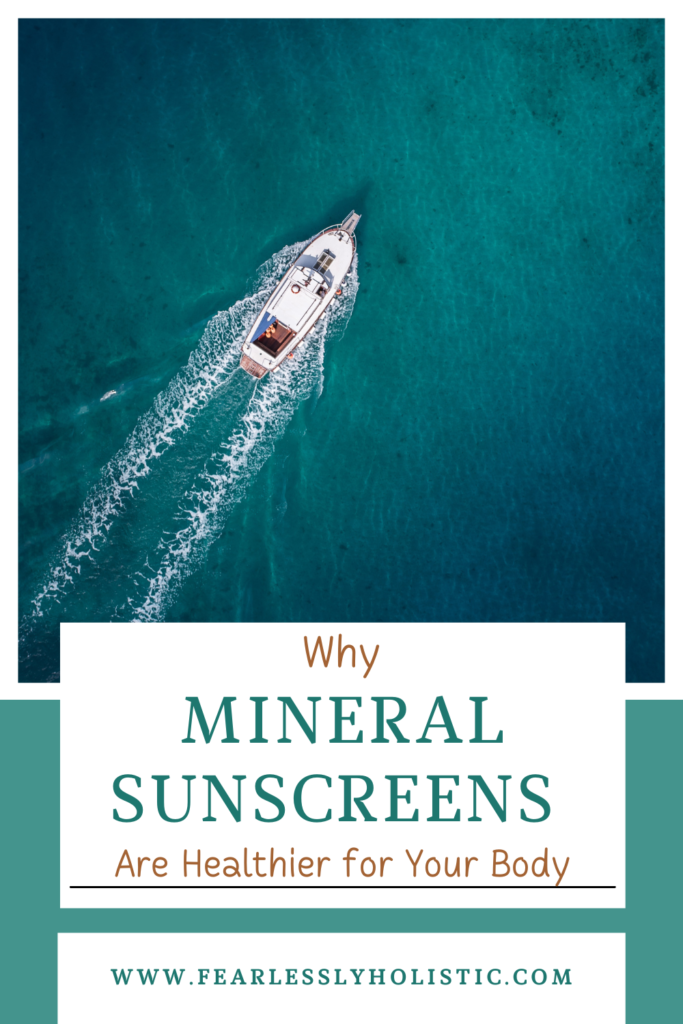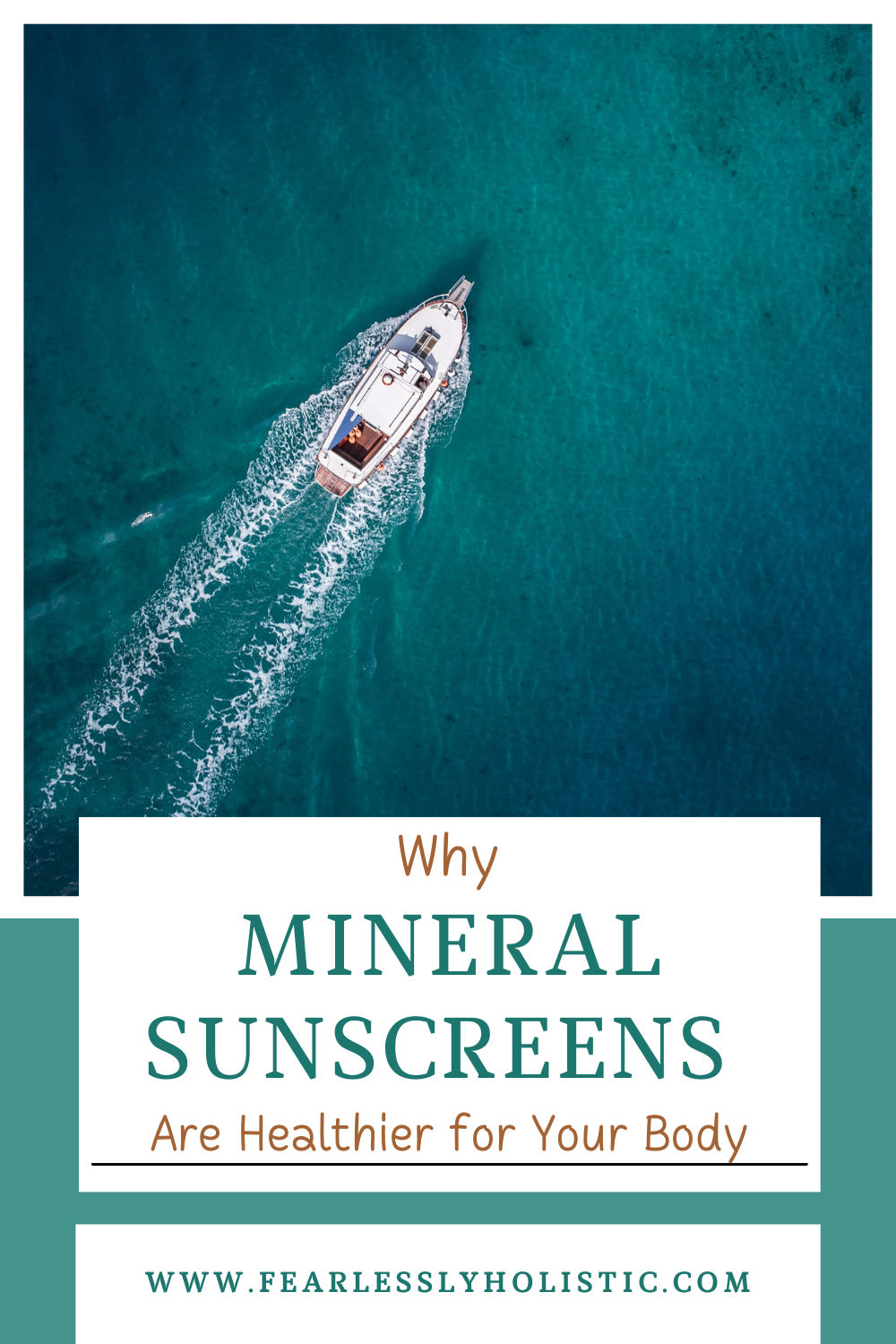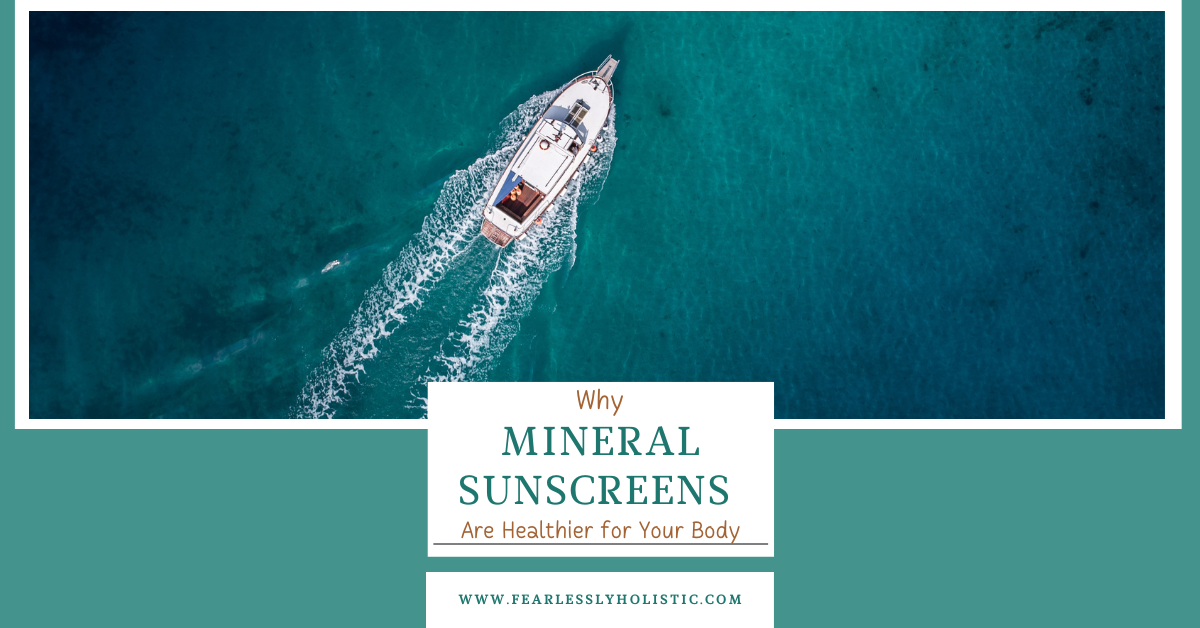For the past couple of summers, I have been testing out various mineral sunscreens. I wanted to try some products with healthier ingredients that are more ‘holistic’.
There are two main types of sunscreens you can choose from – chemical or mineral sunscreen. Mineral sunscreens contain zinc oxide, as well as other natural ingredients like coconut oil and shea butter.
Both varieties will help to protect you from UVA and UVB rays. Just keep in mind that if you put it on your skin, it will be absorbed into your body. So isn’t it better to go as natural as possible?
Hello and welcome to Fearlessly Holistic.
My name is Irma and I want to share my journey to improved health by eating whole foods, moving my body and eliminating stress as much as possible.
It is my hope to inspire you to make daily changes. Why? Because eating fresh, seasonal food, getting some sunshine, and reducing stress is the best way to increase longevity. But you do not want just a long life.
You want a quality long life, and you want to look and feel your best while you live it.
My blog posts are my opinion and the results of things that I have tried that either worked for me or didn’t. My opinions are for informational purposes only and are not intended as medical advice. Medical advice should always be obtained from a qualified medical professional for any health conditions or symptoms associated with them. As well, there may be affiliate links in this post. Read more here.
If you plan to spend time in the sun, and are wondering what’s good in sunscreen these days, you should check out the new crop of mineral sunscreen products.
The primary difference between a mineral sunscreen and a traditional chemical one is in their ingredients. First up, we will look at chemical sunscreens.
And if you are wondering, it is not required to go higher than SPF 50, and most people can safely use SPF 30 and stay protected for long periods in the sun. Read this article from Mark’s Daily Apple for more information.
Chemical Sunscreens
Chemical sunscreens are obviously going to use chemical compounds in their product. The concern for manufacturers is that the ingredients do what they want them to do.
Your health is not a concern to chemical sunscreen manufacturers.
The ingredients are designed to go on smootly, last a specific amount of time, and not leave you with white streaks.
Chemical sunscreen’s ingredients to help protect you from the sun’s UV rays include chemicals like octisalate, oxybenzone, and avobenzone. Scroll down to see the list at the end of this post for a more extenisive list of chemicals.
Benzophenone and oxybenzone are known endocrine disruptors
Endrocrine-disrupting chemicals (EDCs) can lead to health outcomes like cancer, reproductive impairment, cognitive deficits and obesity. Read more at endocrine.org
Environmental Concerns
Chemical sunscreen ingredients are harmful to the coral reefs and sea life.
Many places where you can swim among the reefs will not let you in if you are wearing chemical sunscreens due to the damage they cause. So if they damage coral reefs, imagine what they are doing inside your body when absorbed.
I am not trying to scare anyone; rather I want to help you be aware.
Too much UVA Protection
This might sound like a good thing, but it is not. You want UVB rays on your skin because they trigger Vitamin D production, which is good. That only happens between 10 am and 2 pm, in the Northern Hemisphere.
But you want to balance that with UVA protection to protect skin from premature aging, wrinkles and oxidative stress.
Sunscreen Ingredients to Avoid
Simply by looking at the ingredients on the back of your sunscreen will show these and others to tell you it is a chemical sunscreen.
- Avobenzone
- Benzophenone
- Cinoxate
- Dioxybenzone
- Ensulizole
- Homosalate
- Meradimate
- Oxbenzone
- Octocrylene
- Octisalate
- Octinoxate
- Padimate O
- Sulisobenzone
Also:
Retinols – This is Vitamin A added and it caused cancer in mice in a 2012 study.
Parabens – Are preservatives that have not been well studied, but show up in the urine of people using them on their skin, including infants.
PABA – has been banned by the FDA, but may be available in other parts of the world. Avoid sunscreens from other parts of the world that contain PABA.

Here are some things to know about mineral sunscreen so you can decide if this is a good time to make the switch.
Benefits of Switching to Mineral Sunscreen
The first thing to note is that the FDA recently proposed a rule where they have requirements about ingredients allowed in sunscreen.
This is a great indication that mineral sunscreen might be much better for you.
Mineral sunscreens use ingredients that are more natural and organic
But they still protect you from the sun’s UV rays. Ingredients are typically either titanium dioxide or zinc oxide as its primary sun-blocking ingredient for your skin.
These are minerals shown to help protect your skin from the sun.
You get the sun protection without fillers
Naturally, the best benefit is not having all those chemicals on your skin.
It should be noted that chemical sunscreens have been used for decades, but research is just discovering what their ingredients really do to your health.
If you can get sun protection with minerals, it might be the better choice.
Broad Spectrum
This means they protect against both UVA and UVB rays. They are better for people with sensisitive skin or those who have skin conditions that are made worse by heat.
Mineral Sunscreens are less irritating for sensitive skin
People with sensitive skin or skin disorders like rosacea and eczema often struggle with many standard products for the skin, including chemical sunscreen.
Mineral sunscreen often causes less irritation, because they use a lot of skin-soothing ingredients like shea butter and castor seed oil.
Safer for kids without the added chemicals
Parents might also prefer using a sunscreen on their kids with less irritating ingredients and unnecessary chemicals being absorbed into their young bodies.
‘Reef Safe’ Ingredients
You must read labels to look for this. Some natural sunscreens contain regular zinc oxide and titanium dioxide, which are not reef safe.
Instead, look for non-nano active ingredients, such as non-nano zinc oxide.
Other natural ingredients may be coconut oil, shea butter, sunflower seed wax or castor seed oil.
Plastic-Free Packaging/Vegan
This applies to some products but not all. Many natural sunscreens are labelled ‘Vegan’ and/or PETA certified because they were not tested on animals.
Other products come in biodegradeable packaging which breaks down, depending on conditions, in a few months to a year; unlike plastic which takes decades to decompose.
Buying Mineral Sunscreen
Most sunscreens should be labeled as a mineral sunscreen and there are now many to choose from, in lotions or stick form (like solid deodorant).
Watch for packaging words like:
- Reef Friendly
- Mineral-Based
- Non Nano
- Broad Spectrum
- Vegan Ingredients/Cruelty Free
- Hypoallergenic
- Biodegradeable packing (this is a newer option)
If you like spray sunscreens, look for brands like Elta MD and Sun Bum.
There are also cream mineral sunscreens from brands like Drunk Elephant, Cetaphil, and Banana Boat.
If you have a darker skin tone, you might prefer Unsun.
My sunscreen recommendations
I have been trying out several brands of mineral sunscreen over the past couple of years with different results. I tried a Badger brand one, but it was so thick and hard to get out of the tube and I sunburned using it, so I won’t recommend.
My favorite is a liquid-type by a brand called Saje, but it was not available to me in 2023. I am guessing supply chain issues??
Last summer (2023), I did a lot of research looking for a product I was willing to risk my money on.
I found what I was looking for with a product by the brand Attitude. It is a solid sunscreen in a biodegradable tube. Read my review here > Attitude Mineral Sunscreen.
I highly recommend the Attitude solid sunscreen products. It is in a push-up cardboard tube, it easy to apply, the container is recyclable, so it is eco-friendly as well as being reef-friendly.
It is safe for everyone, including babies.
Conclusion
My main goal is to get outside, starting in April, to specifically build my base tan. I start with 15 minutes at a time and work up from there and I do not wear any sunscreen.
You only get UVB rays when the sun hits your skin between 10 a.m and 2 p.m.
UVB rays on your skin also trigger hormone production of Vitamin D, which is why everyone on the beach seems so relaxed!
My second line of defence is to eat more saturated fat.
I have noticed in many keto and carnivore online threads, that many people are eating more fat so that they can ditch sunscreens.
I did my own test a few years ago, by taking 4 Asthaxanthin (Krill oil) capsules daily for six weeks prior to my annual river tubing holiday. Guess what? No sunscreen and no sunburn.
It makes sense that, for thousands of years, people ate whole foods and worked outside without the need for sunscreen.
Holism targets overall wellness, and when we are well, we only get better with age.
Eat the best food that you can afford to give your body the building blocks it needs for optimal health, longevity, and looking good for as long as possible.
Please share this post with anyone who can benefit from it. Sharing is caring! And follow me on Pinterest!
Until next time, here’s to our health!
-Irma

